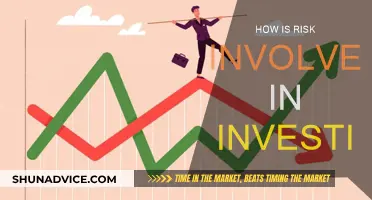
There is a common belief that young people should take more risks with their investments. This is because they have more time to recover from any losses and build their wealth over time. However, this strategy is not without its pitfalls, and young investors should be aware of the potential consequences of their actions. So, should young people make risky investments?
| Characteristics | Values |
|---|---|
| Time | Young people have more time to recover from losses and take advantage of compounding interest. |
| Risk Tolerance | Young people can afford to take more risks because they have more time to recover from losses and less financial responsibility. |
| Flexibility | Young people have more flexibility to take risks because they have fewer financial commitments. |
| Experience | Young people may be less experienced with investing and more susceptible to common mistakes. |
| Goals | Young people may be more focused on short-term spending rather than long-term goals such as retirement. |
What You'll Learn
- Young people can take more risks because they have more time to recover from losses
- Compounding means money invested early is worth more in the long run
- Young investors can seek out bigger returns by taking bigger risks
- Young investors can use leverage to their advantage
- Young investors can afford to take risks on complex, high-growth areas

Young people can take more risks because they have more time to recover from losses
Young people are generally advised to take more risks with their investments because they have more time to recover from losses. This is a common financial motto: "If you're young, take on more risk."
The reasoning behind this advice is that young people have a longer time horizon before they need to access their money for retirement. This means that even if they experience short-term losses due to risky investments, they have more time for their portfolio to recover and grow. Compounding plays a significant role here, as the earlier money is invested, the more it can grow over time.
For example, if a person starts investing at 25, they can become a millionaire by 60 by investing half as much each year as someone who starts at 35. This illustrates the power of starting early and taking advantage of compound interest.
Additionally, young investors can seek out bigger returns by taking calculated risks. They can invest in companies with higher risk but greater upside potential over the long term, such as small-cap stocks. These are smaller, less established companies that may become household names with long-term rising stock values.
However, it is important to distinguish between calculated risks and speculative trades or gambling. Speculative trades and gambling can lead to significant losses that may scar young investors and affect their future investment choices. Instead, young investors should focus on solid companies with long-term upside potential.
While young people have the advantage of time, they also need to be mindful of procrastination. It is essential to start investing early and consistently to take advantage of the long-term growth potential of the stock market, which has historically risen, averaging about 10% per year.
India's Investment Opportunities: Where to Invest Now?
You may want to see also

Compounding means money invested early is worth more in the long run
Compounding is a powerful way to build wealth. It means that the earnings from your investments are added to your original investment, and those earnings then generate their own returns. In other words, compounding allows you to earn interest on your interest.
Compounding is particularly beneficial for young investors because the earlier your money starts compounding, the more pronounced the effect will be. This is because compound interest grows at an accelerating rate—the longer you leave your money, the more it will grow.
For example, if you start saving $100 a month at age 20, earning an average of 4% annually, compounded monthly, across 40 years, you will have earned $151,550 by age 65. On the other hand, if you start saving at age 50, investing $5,000 initially and then $500 monthly for 15 years, also with a 4% average monthly compounded return, you will have earned only $132,147 by age 65.
The power of compounding is also evident when comparing the growth of your money in a savings account with compound interest versus an account with simple interest. If you invest $1,000 at a 5% annual simple interest rate, you would earn $50 in interest each year, and after 5 years, your investment would be worth $1,250. However, with compound interest, your money will grow at an accelerating rate. In the second year, you earn interest on $1,050, not just the original $1,000. This means you'll earn $52.50 in interest, bringing your total to $1,102.50. After 5 years, your investment will be worth approximately $1,276.28, instead of $1,250.
Compounding also applies to bonds. For example, suppose you buy a bond that pays a fixed 4% annual interest. In the first year, you earn $40 on your $1,000 investment. In the second year, if you reinvest the $40 at 4%, you will earn $41.60 because it is based on $1,040.
In summary, compounding means that money invested early is worth more in the long run due to the exponential growth of compound interest.
Fidelity OTC Portfolio: Is It a Smart Investment Move?
You may want to see also

Young investors can seek out bigger returns by taking bigger risks
Young investors can take advantage of their age and increased ability to take on risk by applying investing fundamentals early, which can help lead to a bigger portfolio later in life. For example, a young investor who starts investing at 25 can be a millionaire at 60 with half the annual investments of someone who starts at 35.
However, it is important to note that taking bigger risks does not mean making fast, ill-informed choices. Instead, young investors should focus on solid companies with long-term upside potential. For example, small-cap stocks are a big segment of the stock market that has higher risk but also higher return potential. These are smaller, less established companies, but many of them go on to become household names with long-term rising stock values.
Leverage can also be used to increase risk and potential returns, but it should be approached with caution as it can have detrimental effects on a portfolio.
Overall, young investors have the flexibility and time to take on risk and recover from any mistakes, which can lead to bigger returns over the long term.
Smart Investment Strategies: Making the Right Choices
You may want to see also

Young investors can use leverage to their advantage
However, leverage can be a double-edged sword. While it can increase returns, it can also amplify losses. If a young investor can tolerate a 20% to 25% drop in their portfolio, the 40% to 50% drop that could result from using leverage may be too much to handle.
Therefore, it is important to use leverage in moderation. For example, a young investor with a $100,000 portfolio could consider using 2:1 margin/leverage on a small portion of their portfolio, such as 10%. This would increase the risk and potential returns on those specific trades while keeping the overall risk to the portfolio quite low.
It is also important to remember that investing in high-risk areas should be done with a smaller percentage of your savings. As you approach retirement, it is wise to transition to a slower-growing, more stable portfolio to protect more of your investments.
Additionally, young investors should avoid speculating instead of investing. While they can take on bigger risks, this does not mean they should gamble or make highly speculative trades. Instead, they should invest in companies with higher risk but greater upside potential over the long term, such as small-cap stocks.
By using leverage wisely and focusing on solid companies with long-term upside potential, young investors can take advantage of their age and increased ability to take on risk to build a stronger portfolio for the future.
Creating a Bot to Trade and Invest: A Beginner's Guide
You may want to see also

Young investors can afford to take risks on complex, high-growth areas
Young investors are generally advised to take more risks with their investments than older investors. This is because younger people have more time to recover from any losses they might incur. For example, if a young investor loses money, they can make up for it through future income generation.
Young investors can therefore afford to seek out bigger returns by taking bigger risks. This means investing in areas with the potential for quick growth but a lot of uncertainty. These areas are often complex and high-growth, such as tech stocks or emerging foreign markets. For example, Netflix, Amazon, and eBay were all considered high-risk investments when they first appeared, but they have since become some of the best-known and largest companies in the world.
However, it is important to note that taking risks does not mean making fast, ill-informed choices. Instead, young investors should focus on solid companies with long-term upside potential. They should also avoid gambling or highly speculative trades, as these can lead to large losses that may discourage them from investing in the future.
Additionally, while young investors can tolerate more risk, they often have less income to invest. Therefore, it is important to balance risk with a long-term investment strategy that takes into account the investor's goals and risk tolerance.
¿Qué es Investment Management? Maximizando tus inversiones
You may want to see also
Frequently asked questions
When you're young, you have more time to recover from any losses, so you can afford to take more risks. For example, if you start investing at 25, you can become a millionaire by 60 with half the annual investment of someone who starts at 35.
You should invest in companies that have higher risk but greater upside potential over the long term. For example, small-cap stocks are a big segment of the stock market with higher risk but also higher return potential.
While it's good to take risks, you should avoid speculating or gambling. A large loss can put you off investing altogether, and too much leverage can destroy your portfolio.







